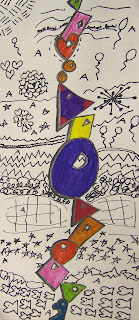This project was a favorite among my 5th graders this year. All of their pieces turned out great and students were able to learn and practice new clay skills.
Students began with a ball of clay which they then rolled and made very smooth. Then, they stuck their thumbs in their balls of clay to form pinch pots. Each student then took their pinch pot, turned it on its side, then scored and slipped features onto the pot to create creatures. This was a great creative outlet for the kids.
After the projects were bisqued, the students were then able to glaze their projects. They looked amazing when they came out of the last firing. This is a project I will keep for next year for sure.
 |
| This one lost his eye in the bisque firing. I glued it on later, after it was glazed |

















